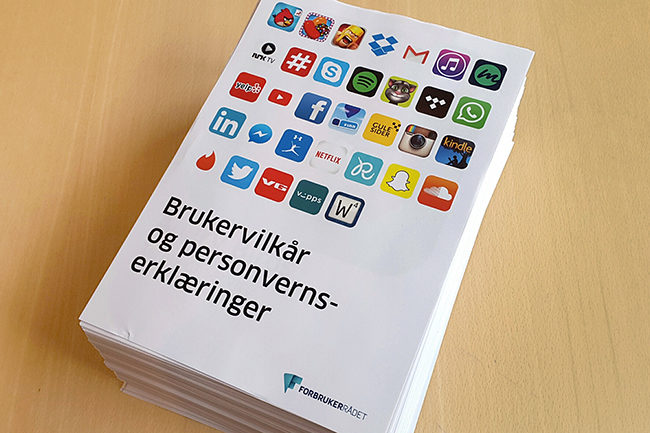250,000 words of app terms and conditions
24. mai, 2016
The average consumer could easily find themselves having to read more than 250,000 words of app terms and conditions. For most people this is an impossible task, and consumers are effectively giving mobile apps free rein to do almost whatever they want.
Read more about the Consumer Council’s Appfail campaign
The Norwegian Consumer Council has downloaded the terms of service and privacy policies for apps that you would find on an “average” mobile. Together they exceed the New Testament in length – and would take more than 24 hours to read out loud.
“The current state of terms and conditions for digital services is bordering on the absurd. Their scope, length and complexity mean it is virtually impossible to make good and informed decisions,” says Digital Policy Director Finn Myrstad at the Norwegian Consumer Council.
“Standards should most definitely be established for how terms, conditions and privacy statements are written and presented.”
The Consumer Council reads out app terms in real time
To demonstrate what reading the terms and conditions actually entails, the Norwegian Consumer Council invited a number of guests to help read out all the app terms and conditions – word by word.

“We hope this can help put the spotlight on a failing contract regime. Few, if anyone, have the time and opportunity to familiarise themselves with what they actually click ‘OK’ to, says Finn Myrstad.
“When we also know that apps often take away our rights by granting themselves the power to unilaterally amend the contract and licensing themselves to track, store and sell on user content, it is self-evident that consumers are put at a disadvantage.”
5 steps towards more comprehensible terms
“The main thing is of course that fundamental consumer rights and privacy concerns are safeguarded by apps and other digital services. That said, there are a number of things that can be done to clarify what consumers are actually saying yes to,” according to Myrstad.
How terms and conditions can be made more reader-friendly:
1. Cut back on the obvious
If what you are saying is regulated by rules and regulations, it may be enough to refer to and adhere to these.
2. Write so that people understand
Write so that users understand what you are trying to say. Avoid legal terms, words and concepts that sow doubt and leave room for interpretation. Avoid writing whole paragraphs using capital letters.
3. Keep it short and concise
You cannot expect users to read page after page. Limit the length of what you are asking your users to digest.
4. Structure the text
Highlight the most important elements, either by structuring the text, using graphics or by other means. Clarify any changes that will take place with updates, including those that may be perceived as negative.
5. Adopt an industry standard
By creating and adopting a good industry standard, it will be possible to cut back on individual terms and conditions. It builds trust and is easier to relate to.
The calculation
A Norwegian consumer has an average of 33 apps on her mobile. We have chosen apps to reflect an “average” Norwegian consumer based on app type and popularity. The number of words used in the terms, conditions and privacy policies associated with the apps exceed 250,000.

Øyvind H. Kaldestad
Kommunikasjonsrådgiver – digitale rettigheter og strøm